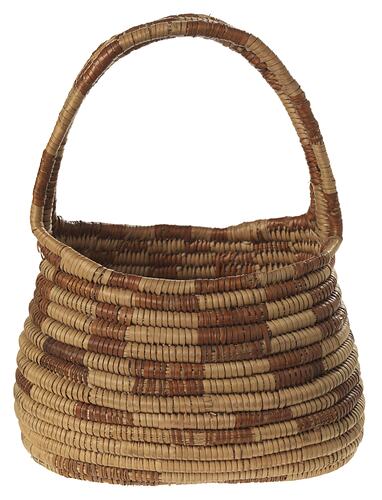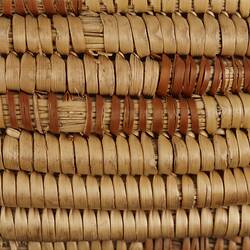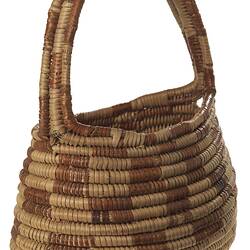Summary
This small oval-shaped binak (basket) was most likely purchased from Coranderrk Aboriginal Station around the 1870s or 1880s. It has been made using the bundle-coil technique, traditionally practised by Aboriginal women of south-eastern Australia and used to make a range of small and large baskets. The basket's woven light and dark chequer design is very rare.
Pre-contact, baskets made by Victorian weavers did not have fixed handles; they were made without them or with a string made from handspun plant fibre attached to the back of the basket. Baskets were made using a variety of fibres, including tussock grass, spiny-headed mat-rush, flax, sedge and reed.
The establishment of church-run missions and stations saw a focus on teaching Aboriginal women domestic duties, such as sewing and basket making, in the European style. Aboriginal women adapted their style of basket-making, which had been practiced over countless generations, to be more attractive to European tastes. Decorative elements and stitches were added, and features of European basketry such as fixed handles were incorporated. Basket making became an important part of economic life for Aboriginal women, on and off the missions
Binak is the Wurundjeri word for basket - see Keeler, C. and Couzens, V., (eds) 2010, Meerreenng-An. This is my Country: The Story of Aboriginal Victoria Told Through Art, Melbourne Koorie Heritage Trust. BPA Print Group, Page 234
Local Name
Binak
Physical Description
Coiled basket with oval base, it is tubular in shape with a single handle. Made using the bundle-coil technique. Light and dark plant fibre have been woven as to produce a chequered pattern along the body and handle of basket.
Significance
In 1863, desperate for a safe haven for their people which would protect them from the ravages of colonisation, Kulin leaders Simon Wonga and William Barak, with the help of Superintendent John Green, established the Coranderrk Aboriginal Station. At the junction of the Yarra River and Badger Creek near the town today known as Healesville in the Yarra Valley, Coranderrk aspired to be a self-supporting community. Comprising 4850 acres, Coranderrk became one of the most productive stations in the Yarra Valley. By 1875 more than 100 Aboriginal residents worked and lived at Coranderrk, building and living in their own family homes and constructing a school for their children. The station ran a substantial milking herd, horses, pigs, poultry, orchard, a market garden and a working hop field. The Kulin people at Coranderrk, unlike many other Kulin peoples living in religious mission stations set up throughout Victoria, were free to continue to hunt and gather traditional foods alongside their work on the station. Many Kulin men also earnt wages shearing sheep for neighbouring graziers while women made money selling their own handmade goods such as baskets and rugs to the many tourists who visited the area.
In 1923, largely as a result of being too successful, the government officially shut down Coranderrk Station which was now on much sought-after prime land. Many of its residents were removed to Lake Tyers Mission in Gippsland but several residents refused to leave.
More Information
-
Object/Medium
Basket
-
Maker
-
Locality
-
Date Produced
-
Object Measurements
200 mm (Length), 140 mm (Width), 250 mm (Height)
-
Classification
-
Date Made
-
Maker
-
Clan/Language Group
-
Place Made
-
Indigenous Region
-
Keywords
-
Type of item
-
Discipline
-
Category
-
Collecting Areas













